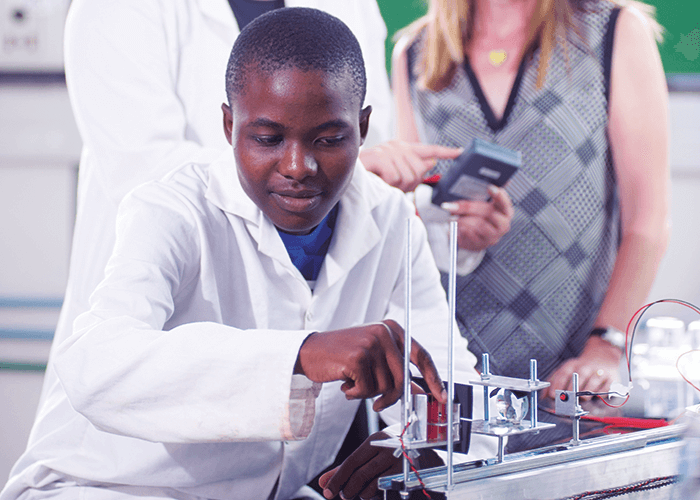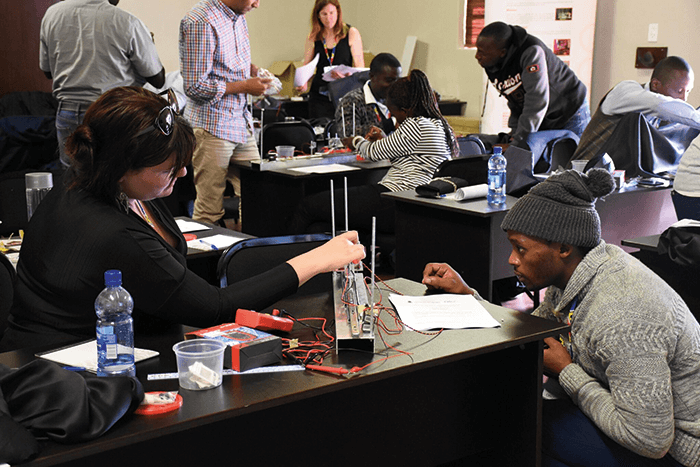The Problem
Instruments are becoming more automated, robust and rugged. And though such advances are great in terms of measurement repeatability, from an educational point of view it’s a bad thing – students have less interaction with the instruments, specifically with spectrophotometers. The opportunity to learn is limited, and this really impacts on their understanding and interpretation of their results. Considering the cross-cutting applicability of spectrophotometry, this lack of understanding needs to be addressed.
Background
In my practical sessions for students, I noticed that little thought was given to how the instruments were actually working. Students would open the lid of the instrument, put in their cuvette, close the lid, press the button, and get a number. It was just a results-spewing “black box” to them, and the concept of what was actually going on inside the instrument was completely missing. I wanted to change that. As educators, when we want to teach our students how a black box works, we break it down into smaller boxes on the whiteboard or in a PowerPoint presentation – we have the source, the detector, and so on. We decided we needed an educational instrument that followed the same approach – a spectrophotometer that allows students to touch all the components to really see how they work, as well as getting a feel for how changing one element can affect the results. We also wanted to encourage them to be more innovative and have a more enquiry-based approach to learning about spectrophotometry. The University of York had already developed a DIY spectrophotometer some years ago, which I appreciated for its simplicity and circuit design, but I really wanted the components to move. I didn’t want the cuvette to be in contact with the circuit board – because, inevitably, students will take a shortcut and pour their solutions directly into the cuvette on the circuit board, frying the most expensive component. We needed an alternative; thus, the SpecUP was born (1).The Solution
I had some funding available and a third-year mentorship student who was studying a co-major in physics and chemistry, and we worked together to develop the kit as it stands today.We had several requirements when developing the instrument. It had to:
- Be available as a kit to be assembled by students
- Have accessible manual settings for component parts
- Be sufficiently rugged to withstand repeated use
- Be able to generate analytically spectroscopy-related applied experiments
- Be built so that the electronic component of the instrument was not the focus of the experiment
- Be significantly lower in cost than commercially available instruments.

Beyond the Solution
The funders saw that the SpecUP could be valuable beyond my own institution. They helped me apply to set up a workshop so that we could roll out the SpecUP to various institutions in Africa, and from there it’s just taken off. There are now 20 countries with instruments, which is phenomenal. The last workshop we had, in September 2016, was part of a bigger “Teaching the Teachers” session, which focused on a range of different optics-related experiments and instrumentation – expanding on the initial idea. Naturally, some teachers prefer the ease of a commercial instrument, but others have really taken the SpecUP on board. In Stellenbosch, I was approached by teachers in the food science department to create a targeted workshop specifically for them. The Nelson Mandela Metropolitan University in South Africa is developing some new practical sessions using the instrument, and are even using it for their outreach to schools. I would really like to get SpecUP into even more institutions. I have no experience in manufacturing or business-related activities, and it would be wonderful to have a company on board that could manufacture the parts and produce more kits. At the moment, the more we make, the more pressure there is on our department – and it’s not really what our team is set up for. In addition, our current poor exchange rate is causing a real financial strain – the last set of kits that we prepared cost significantly more than the previous ones. They are still much cheaper than the commercial instruments, but we have a limited budget. The South African government are keen to increase the number of graduates in all institutions throughout the country. We have two new universities being set up, but those expectations also put a lot of pressure on existing facilities. During the time I’ve been at the University of Pretoria, I’ve seen the number of students in the classes more than double, and although we received funds to upgrade our facilities, this was centred on infrastructure – we were able to buy new lab benches, but not the instruments to put on them! There’s a bottleneck, and we need to be more creative about education, so that students aren’t at a disadvantage because of a lack of commercial instrumentation. I think the SpecUP is the perfect tool to help fill that gap. Patricia Forbes is Associate Professor of Analytical Chemistry at the University of Pretoria, South Africa. For more on student-proof instruments click here.References
- P Forbes, J Nöthling, “Shedding light on spectrophotometry: The SpecUP educational spectrophotometer”, S Afr J Sci, 110, 2013-0096 (2014).




